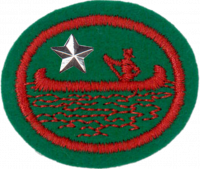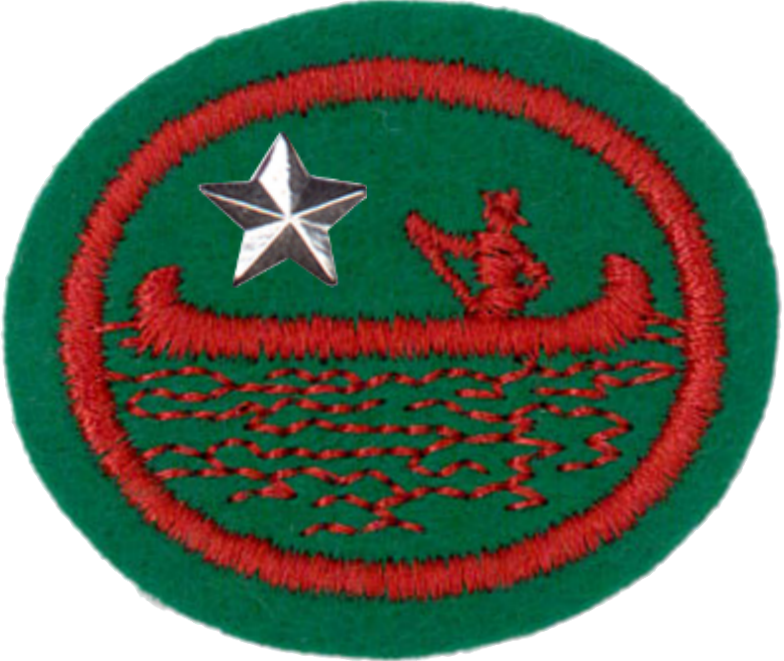Difference between revisions of "AY Honors/Canoeing - Advanced/Answer Key"
| Line 25: | Line 25: | ||
{{ansreq|page={{#titleparts:{{PAGENAME}}|2|1}}|num=2a}} | {{ansreq|page={{#titleparts:{{PAGENAME}}|2|1}}|num=2a}} | ||
<noinclude><translate><!--T:27--> | <noinclude><translate><!--T:27--> | ||
| + | Little or no current, you can paddle up stream | ||
</noinclude> | </noinclude> | ||
<noinclude></translate></noinclude> | <noinclude></translate></noinclude> | ||
Revision as of 20:41, 16 September 2021
Skill Level
2
Year
2013
Version
30.12.2025
Approval authority
North American Division
*
1
For tips and instruction see Canoeing.
2
2a
Little or no current, you can paddle up stream
2b
2c
2d
2e
2f
3
- Life jacket
- Paddle
- 1 Wool/fleece shirt
- 1 Long sleeve shirt nylon or polyester/cotton blend
- 2 T-shirts
- 1 Pair medium weight wool socks
- 2 Pair light weight socks
- 2 Underwear
- Pair of gloves
- Hat
- Buff
- Polarized sunglasses
- Light weight footwear for around camp
- Shoes with arch support for portaging
- Water shoes
- Large bailing sponge
- Day pack or fanny pack
- Flashlight or headlamp
- Extra batteries
- Multi tool
- Belt
- Matches or lighter
- Hand sanitizer
- Whistle
- Two-piece rain suit
- Jacket
- Camera and water proof bag optional
- Hand cream, lip balm, sunscreen, bug spray
- Towel, wash cloth and toiletries
- Biodegradable soap/shampoo
- Map
- Sleeping bag and pad
- Duluth packs/ liners/ dry pack
- First aid kit
- Personal medication
- Aqua tablets or water purifier
- Toilet paper
4
Extra map, tents, cooking kit, tarp, biodegradable soap & scrubby, stove, fuel, folding saw and or an ax in a sheath, rope/Paracord 100 ft., nylon cord or buggies to secure gear, Duluth packs, liners, dry pack, candles, fire starters, matches, lighters, trowel, folding water jug.
5
Weather radio, GPS, cell phones, signal kit (mirrors, flares), duct tape for emergency repairs and an extra paddle per canoe, medical kit: Assortment of Band-Aids, alcohol wipes, gauze pads, waterproof tape, hydrocortisone cream, triple antibiotic ointment, menthol pain relieving gel, tweezers, pain relievers, Benadryl, activated charcoal, elastic bandage, triangle, burn dressing kit, 2 pair disposable gloves, needle and thread.
6
- Wound materials: five 0.75 x 3 in. adhesive bandages, five 1 x 3 in. adhesive bandages, 5 knuckle elastic bandages and 5 fingertip elastic bandages
- Also includes two 2 x 2 in. gauze pads, a 9 x 5 in. abdominal/pressure pad and 6 butterfly closure strips
- Two 4 x 4 in. gauze pads, two 3 x 2 in. non-adherent pads and a 2 in. x 4.1 yards stretch gauze roll
- Prep and care for wounds with a SaniHands wipe, 3 antibacterial wipes, 3 triple-antibiotic ointment packets, 2 iodine wipes and 3 Soothe-A-Sting wipes
- For sprains and blisters: a 2 in. elastic bandage, two 3 x 4 in. moleskin patch and a 1 in. x 10 yds. porous tape
- Medications include 2 acetaminophen, 2 ibuprofen and 2 antihistamine
- Equipment includes 4.5 in. stainless-steel bandage scissors, 3.5 in. splinter forceps and NeoPro latex-free gloves, needle and thread
7
Usually early mornings are the calmest time on a lake. If you must canoe when it is windy you should stay to the edges of the lake because the wind is much stronger in the middle.
8
Unfortunately, there is no universally agreed-upon, standardized set of hand signals for canoeing safety. It is therefore very important that you review the signals you intend to use prior to departing, especially if your group consists of people who have not paddled together before, or come from different regions. Failure ot heed this advice could lead to tragedy, as some signaling systems point to danger, while others point to safety. The signals presented here are probably as close to "standard" as we are likely to find, as they are promoted by the American Whitewater Association, and therefore, have been circulated widely.
9
9a
9b
9c
Arranging the shuttle is one of the most complicated logistical activities you will engage in on a typical canoe trip.
- Guide Services
- Hiring a guide to do this for you is the easiest, but it is also more expensive. They are usually equipped to move canoes, people, and gear along the watercourse they serve.
- Most cars at the put-in
- With this approach, you will need at least three adults. The idea is that you leave all the boats and gear at the put-in with at least one adult, while two adults drive two vehicles to the take-out, leave one vehicle there, and then return to the put-in. When you reach the take-out by canoe, you must then transport as many drivers as you can back to the put-in the retrieve the other vehicles, while leaving as few at the take-out as possible to keep an eye on the boats and gear.
- Most cars at the take-out
- With this approach, you leave all the boats and gear at the put-in in the care of as few people as possible, while everyone else drives all the vehicles possible to the take-out. Then all the drivers pile into as few vehicles as possible (ideally, one) and return to the put-in. The advantage of this method is that when you reach the take-out by boat, most people can stay there and begin loading the gear and boats into and onto the vehicles while two people return to the put-in to retrieve the vehicle that was left there.
- Arrange for a driver
- This is similar to hiring a guide, but instead of getting someone with equipment to move boats, gear, and people, you use a friend who will not be going on the trip. This person will transport drivers from the take-out to the put-in, either before or after the trip. It is usually easier to do this before the trip, as it is easier to know exactly when your friend's service will be needed at the beginning of the trip vs the end. Many clubs have staff members who are willing to help, but are not able to participate in physical activities.
Which method you use depends on the amount of parking (and the relative security) of the put-in and take-out locations, as well as the amount of money available, or the willingness of a friend.
There are other approaches as well (such as leaving a bike at the take-out and riding it back to the put-in). Whichever method you use, be sure to think it through before you find yourself stranded at the take-out.
9d
9e
9f
9g
10
Here are some menu ideas:
Breakfast
- Pancakes, maple syrup, hot cider
- Oatmeal, dried fruit, hot cocoa
- Granola, powered milk, hot tea
Lunches- are usually not cooked
- Trail Mix, cheese & crackers
- Granola Bars, lemonade
- fruit leather, Chex mix
- pita bread or tortillas, cheese, tea
Suppers
- Rice and beans, hot cocoa
- Noodles with sauce, dried vegetable, cider
- Dried mashed potatoes, red cabbage salad (wrap the cabbage, carrots and onion in a paper bag or towel and put in a pot. It will keep for several days.)
- Noodles with instant vegetable soup, lemonade
11
12
12a
12b
13
13a
13b
14
You can also meet a requirement for Christian Storytelling, and that honor has good guidance for this requirement.
References:
- Expedition Canoeing by Cliff Jacobson
- http://Gorp.com/weekend-guide/paddling-advice-guide-sp.html
- Appalachian Mountain Club River Guides
- http://www.boatingsidekicks.com/smartstart800.html


